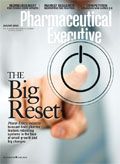Definitions for the New Decade
Pharmaceutical Executive
Pharma must get its definitions right to be successful in the new decade.
This issue marks not only the start of another year—our 30th—it's also the launch of a new decade. If there is a theme to characterize the decade just passed, it is how Big Pharma found its mission and business model defined by others, rather than by itself. Ten years ago, industry could use the hubristic purple poetry of Invictus as its mission statement. Today, Coleridge's albatross might be more apt.

William Looney
Pharm Exec's 2010 Industry Forecast contends that success in the new decade will depend on how well industry adapts to market change; resisting is not an option. Flexibility can be a powerful means to uncover new pathways for growth, so long as industry is comfortable with the terms of engagement and can shape the discussion on decisions affecting its external operating environment.
In other words, if the industry doesn't want to be redefined as a public utility rather than a profitable business, it has to ensure that the public knows who it is, how and what it does, and for whom. In short, tell your own story or have it told for you.
Here are a few "theme drivers" where industry can do a better job defining what the issue is, and where it stands.
Better information is the preferred solution to every problem facing the healthcare system, but underlying this consensus is a startling misunderstanding about how to apply information effectively. Information by itself is not evidence; evidence derived from information is not knowledge; and knowledge is not useful unless it can be translated into actions that drive better health outcomes. This premise must be explained if industry is to shape the spread of "evidence-based medicine" tools whose too rigid application will promote rationing. Information is all about context; the methodologies that payers are using to quantify a medicine's "value" must permit the broadest interpretation of results—in the field, under real time conditions, and with the patient in mind.
In defining its commitment to medicines innovation, the industry's focus has been on setting metrics around the R&D enterprise. Not only does this approach lend too much attention to the productivity of the enterprise, which is susceptible to periodic droughts, it is also too narrow. Others are doing a better job of explaining the economic gains from "hidden innovation" in areas like product design, organizational behavior, and copyright. Regulators are following suit, as witnessed by the UK's recent decision to revise its assessment of business innovation capacity to incorporate broader performance measures than spending on R&D and patent citations—the two key areas where pharma ranks high. Preserving the industry's status as "most innovative" will require a redefinition of its own metrics of performance, so that process innovation counts as much, if not more, than product innovation.
Marketing is another area where definition will drive the outlook for industry. At present, the function is seen almost exclusively as product promotion, with no attention to the fact that registration approval does not confer access to the medical community or to the patient. Rather, it falls to the manufacturer to build awareness of the therapeutic merits of a new medicine. Considering that it takes an average of 17 years for a drug treatment guideline to be established as standard of practice, this contribution to medical knowledge has never been made plain by industry.
Finally, industry needs to explain the significant transition occurring in the application of intellectual property. Biopharma is arguably the one sector where IP is still a mission-critical function, but conditions of engagement are shifting. Few stakeholders understand how court rulings are narrowing the grounds for patentability, or that the need to share the higher cost of R&D is driving company interests toward finding alternative ways to safeguard knowledge rights.
William Looney
Editor-in-chief
Asembia 2025: Therapy Advancements Highlight Growing Cost and Access Concerns
April 30th 2025Fran Gregory, VP, emerging therapies, Cardinal Health, discusses the evolving cell and gene therapy landscape, highlighting pipeline growth, cost challenges, and emerging therapeutic areas beyond oncology and hematology.
Addressing Disparities in Psoriasis Trials: Takeda's Strategies for Inclusivity in Clinical Research
April 14th 2025LaShell Robinson, Head of Global Feasibility and Trial Equity at Takeda, speaks about the company's strategies to engage patients in underrepresented populations in its phase III psoriasis trials.
FDA Approves Nipocalimab for the Treatment of Generalized Myasthenia Gravis
April 30th 2025Approval is based on results from the pivotal Vivacity-MG3 trial in which IMAAVY (nipocalimab-aahu) demonstrated superior disease control throughout 24 weeks when compared to placebo plus standard of care.
Beyond the Prescription: Pharma's Role in Digital Health Conversations
April 1st 2025Join us for an insightful conversation with Jennifer Harakal, Head of Regulatory Affairs at Canopy Life Sciences, as we unpack the evolving intersection of social media and healthcare decisions. Discover how pharmaceutical companies can navigate regulatory challenges while meaningfully engaging with consumers in digital spaces. Jennifer shares expert strategies for responsible marketing, working with influencers, and creating educational content that bridges the gap between patients and healthcare providers. A must-listen for pharma marketers looking to build trust and compliance in today's social media landscape.
FDA Approves AbbVie’s Rinvoq as First Oral JAK Inhibitor for Giant Cell Arteritis
April 30th 2025AbbVie secures FDA approval for Rinvoq as the first oral Janus kinase inhibitor indicated for giant cell arteritis, expanding its immunology portfolio and signaling strategic growth opportunities in underserved autoimmune markets.
